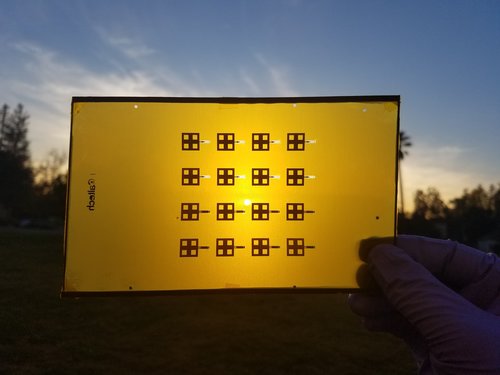
Cr: Caltech space solar
THE SCIENCE FICTION WRITER ISAAC ASIMOV RELEASED A SHORT STOREY CALLED “REASON” IN 1941. IT WAS A CAUTIONARY TALE ABOUT ROBOTICS AND AI, BUT IT’S ALSO RENOWNED FOR ITS FANTASTICAL SETTING: A SPACE STATION THAT COLLECTED SOLAR ENERGY AND SENT IT VIA MICROWAVE TO THE PLANETS. SINCE THEN, SPACE-BASED SOLAR POWER HAS REMAINED A FAR-FETCHED CONCEPT—SOMETHING WITH THE POTENTIAL TO REVOLUTIONISE THE PLANET IF WE CAN MASTER THE TECHNOLOGY AND RAISE THE NECESSARY FINANCES.
The sun never sets and clouds never form in high Earth orbit, making it an ideal location for a solar farm. However, most previous designs were unrealistically and unaffordably large in order to generate a significant amount of electricity. Engineers drew massive truss constructions, often measured in kilometres or miles, to which photovoltaic panels or mirrors were mounted, absorbing or concentrating sunlight to convert it to direct current, and then transmitting it to the ground through laser or microwave beams. To construct a single installation, hundreds of rocket launches may be required. It was a case of technology being too big to succeed.
Caltech announced that a businessman and university trustee has given the university more than $100 million to research equipment to harvest solar power in space and transmit it down to Earth.
The ability to collect solar electricity in space and send it wirelessly to Earth via microwaves ensures that terrestrial power is available regardless of weather or time of day. Solar power might be supplied 24 hours a day, 7 days a week, wherever on the planet.
The modular assembly of ultralight, foldable, 2D integrated pieces is the foundation of our design. This notion allows for scalability while also reducing the impact of local element failure on other sections of the system.
They exhibited the lightest integrated multifunctional prototype (by an order of magnitude) that absorbs solar, transforms it to RF electrical power, and then wirelessly transmits that power in a steerable beam.
By combining ultralight and shape-accurate materials with high-efficiency photovoltaics and large-scale phased array power transmission into a two-dimensional scalable, deployable spacecraft, our research addresses the basic obstacles connected with deploying space solar.
After reading an article in Popular Science on the possibilities for space-based solar energy manufacture, Donald Bren approached Caltech’s then-president Jean-Lou Chameau in 2011 to discuss the creation of a space-based solar power research project.
Donald Bren is best known for master designing and master building the all-new City of Irvine, which is consistently ranked as one of the greenest communities in the United States. He has led the Irvine Company’s attempt to permanently conserve more than 60% of the Irvine Ranch land (57,500 acres) along the California coast.
SSPP aspires to provide a global supply of affordable, renewable, and clean energy in the future. One of the biggest advantages of capturing solar electricity from orbit is that it gives you access to the sun all day, every day, without being limited by weather or nighttime darkness.
“Solar energy is the most abundant energy source on the planet. At the earth’s surface, however, sunlight is sporadic. Because sunlight shines continuously in space, this ambitious project is a game-changing approach to large-scale solar energy harvesting for the Earth that eliminates intermittency and the need for energy storage “SSPP researcher Harry A. Atwater, Otis Booth Leadership Chair of the Division of Engineering and Applied Science and Howard Hughes Professor of Applied Physics and Materials Science, and director of the Liquid Sunlight Alliance, says
Caltech’s 2500 orbiting solar panels could provide limitless energy to the planet.
The Earth will receive endless solar energy from tiny solar panels that cover more than 3.5 square kilometres.
The question of power is one of the most pressing issues facing the twenty-first century: how to generate enough of it, how to manufacture it cheaply and with the fewest damaging side effects, and how to get it to users.
The concept of beaming solar energy from space to Earth is brilliant, simple, and may just work—given the necessary funding and investment. SSPI has devised a modular strategy that ensures minimal costs and redundancy. A “multifunctional tile,” a lightweight photovoltaic segment that is 10 by 10 cm (4 x 4 in), is just 3 cm (1 in) thick, weighs around 0.8 gramme (0.03 oz. ), and may flatten when combined for launch, is the basic unit.
With 900 panels per satellite, 400 of these basic tiles are combined into panels. Each of these “carpet” satellites can be folded into a small space for launch and then unfold to its full extent while in orbit, which is roughly two-thirds the size of a football field.
2500 of these satellites will fly in a close configuration, forming a solar power surface of 9 square kilometres, according to the plan (3.5 square miles). Each tile has the ability to transform solar energy into radio energy that may be transmitted to (and received on) Earth.
Meanwhile, the lightweight tiles, which are inexpensive to produce, resulting in a more durable space system. Long-term spacecraft wear and tear, such as solar flare or micrometeorite damage, might knock out a tile or two, but it wouldn’t be fatal to the spaceship as a whole.
“[Launch] is now expected to be Q1 2023,” said Ali Hajimiri, the project’s co-director.
Hajimiri continued, “The ultimate system is envisioned to comprise of numerous deployable modules flying in close formation and operating in synchrony with one another.” “Each module has a side length of several tens of metres, and the system can be expanded over time by adding more modules.”
The X-37B’s most recent mission, the space plane’s sixth overall, launched in May 2020. It’s unknown when the winged vehicle will be brought down; most X-37B missions are classified, including the identification and function of most of the cargo.
Sources:
https://www.spacesolar.caltech.edu/
https://interestingengineering.com/caltechs-space-based-solar-power-project-could-power-our-planet














